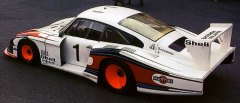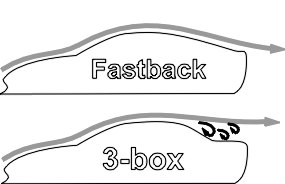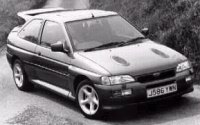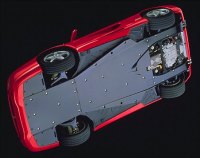Drag and Lift
Drag
Aerodynamic efficiency of a car is determined by its Coefficient of Drag (Cd). Coefficient of drag is independent of area, it simply reflects the influence to aerodynamic drag by the shape of object. In theory, a circular flat plate has Cd 1.0, but after adding the turbulence effect around its edge, it becomes approximately 1.2. The most aerodynamic efficient shape is water drop, whose Cd is 0.05. However, we cannot make a car like this. A typical modern car is around 0.30.
Drag is proportional to the drag coefficient, frontal area and the square of vehicle speed. You can see a car travelling at 120 mph has to fight with 4 times the drag of a car travelling at 60 mph. You can also see the influence of drag to top speed. If we need to raise the top speed of Ferrari Testarossa from 180 mph to 200 mph like Lamborghini Diablo, without altering its shape, we need to raise its power from 390 hp to 535 hp. If we would rather spend time and money in wind tunnel research, decreasing its Cd from 0.36 to 0.29 can do the same thing.
Fastback
 In
the 60s, motor racing engineers started to take aerodynamics seriously.
They discovered that if they reduce the slope of the back of a car to
20
degrees or less, the air flow will follows the roof line smoothly and
dramatically
reduce the drag. They termed this design as "Fastback". As a result,
many
racing cars, such as the Porche 935 / 78 "Moby Dick" shown here, added
an exaggerately long tail and lower the back.
In
the 60s, motor racing engineers started to take aerodynamics seriously.
They discovered that if they reduce the slope of the back of a car to
20
degrees or less, the air flow will follows the roof line smoothly and
dramatically
reduce the drag. They termed this design as "Fastback". As a result,
many
racing cars, such as the Porche 935 / 78 "Moby Dick" shown here, added
an exaggerately long tail and lower the back.
 For
a 3-box car, air flow leaves the car straightly at the end of roof
line.
The dramatic drop of rear screen creates a low pressure area around,
this
attracts some air flows back to complement, thus creates turbulence.
Turbulence
always deteriorates drag coefficient.
For
a 3-box car, air flow leaves the car straightly at the end of roof
line.
The dramatic drop of rear screen creates a low pressure area around,
this
attracts some air flows back to complement, thus creates turbulence.
Turbulence
always deteriorates drag coefficient.
However, this is still better than something between a 3-box and a fastback. If the rear screen angle is around 30 to 35 degrees, the air flow will be very unstable. It could greatly deteriorate the high speed stability. In the past, car makers had little knowledge about this and created many cars like this.
Lift
Another important aerodynamic factor is Lift. Since air flow above the car travels longer distance than air flow underneath the car, the former is faster than the latter. According to Bernoullis Principle, the speed difference will generate a net negative pressure acted on the upper surface, which we call "Lift".
 Like
drag, lift is proportional to area (but surface area instead of frontal
area), the square of vehicle speed and Lift Coefficient (Cl), which is
determined by the shape. At high speed, lift may be increased to such
an
extent that the car becomes very unstable. Lift is particularly serious
at the rear, you can easily understand, since a low pressure area
exists
around the rear screen. If the rear lift is not adequately counter,
rear
wheels will become easy to slip, and that is very dangerous for a car
travelling
at something like 160 mph.
Like
drag, lift is proportional to area (but surface area instead of frontal
area), the square of vehicle speed and Lift Coefficient (Cl), which is
determined by the shape. At high speed, lift may be increased to such
an
extent that the car becomes very unstable. Lift is particularly serious
at the rear, you can easily understand, since a low pressure area
exists
around the rear screen. If the rear lift is not adequately counter,
rear
wheels will become easy to slip, and that is very dangerous for a car
travelling
at something like 160 mph.
Fastback is particularly bad in this aspect, because it has a very big surface area in contact with air flow. It seems that good drag and good lift are mutually exclusive, you can't have both of them. However, as we did more research on aerodynamics, we found there are some solution to achieve both of them ....



 Spoiler
is the aerodynamic kit that alter the air flows underneath the car. We
call those installed at the bottom edge of front bumper as "Chin
Spoiler"
or "Air Dam", and those installed at the bottom edge of the car's sides
as "Skirt". To understand its principle, we must first talk about
underside
air flow.
Spoiler
is the aerodynamic kit that alter the air flows underneath the car. We
call those installed at the bottom edge of front bumper as "Chin
Spoiler"
or "Air Dam", and those installed at the bottom edge of the car's sides
as "Skirt". To understand its principle, we must first talk about
underside
air flow.

